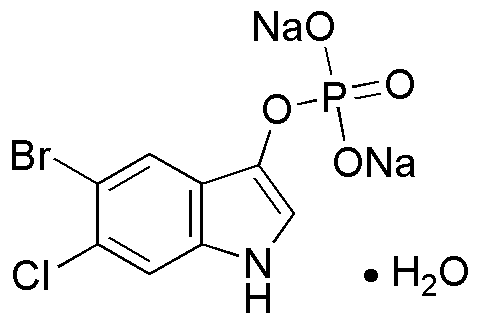5-Bromo-6-chloro-3-indoxyl phosphate disodium salt monohydrate is widely utilized in research focused on:
- Histochemical Staining: This compound is commonly used as a substrate in histochemistry, allowing researchers to visualize enzyme activity in tissue samples, which is crucial for understanding various biological processes.
- Biochemical Assays: It serves as a reagent in biochemical assays to detect phosphatase activity, aiding in enzyme characterization and the study of metabolic pathways.
- Cell Biology: In cell biology, it is employed to study cellular signaling pathways, providing insights into how cells communicate and respond to their environment.
- Pharmaceutical Research: This compound is valuable in drug development, particularly in screening for potential inhibitors of phosphatases, which are important targets in various diseases.
- Environmental Studies: It is also used in environmental research to assess the impact of pollutants on biological systems, helping to evaluate ecosystem health.
General Information
Properties
Safety and Regulations
Applications
5-Bromo-6-chloro-3-indoxyl phosphate disodium salt monohydrate is widely utilized in research focused on:
- Histochemical Staining: This compound is commonly used as a substrate in histochemistry, allowing researchers to visualize enzyme activity in tissue samples, which is crucial for understanding various biological processes.
- Biochemical Assays: It serves as a reagent in biochemical assays to detect phosphatase activity, aiding in enzyme characterization and the study of metabolic pathways.
- Cell Biology: In cell biology, it is employed to study cellular signaling pathways, providing insights into how cells communicate and respond to their environment.
- Pharmaceutical Research: This compound is valuable in drug development, particularly in screening for potential inhibitors of phosphatases, which are important targets in various diseases.
- Environmental Studies: It is also used in environmental research to assess the impact of pollutants on biological systems, helping to evaluate ecosystem health.
Documents
Safety Data Sheets (SDS)
The SDS provides comprehensive safety information on handling, storage, and disposal of the product.
Product Specification (PS)
The PS provides a comprehensive breakdown of the product’s properties, including chemical composition, physical state, purity, and storage requirements. It also details acceptable quality ranges and the product's intended applications.
Certificates of Analysis (COA)
Search for Certificates of Analysis (COA) by entering the products Lot Number. Lot and Batch Numbers can be found on a product’s label following the words ‘Lot’ or ‘Batch’.
*Catalog Number
*Lot Number
Certificates Of Origin (COO)
This COO confirms the country where the product was manufactured, and also details the materials and components used in it and whether it is derived from natural, synthetic, or other specific sources. This certificate may be required for customs, trade, and regulatory compliance.
*Catalog Number
*Lot Number
Safety Data Sheets (SDS)
The SDS provides comprehensive safety information on handling, storage, and disposal of the product.
DownloadProduct Specification (PS)
The PS provides a comprehensive breakdown of the product’s properties, including chemical composition, physical state, purity, and storage requirements. It also details acceptable quality ranges and the product's intended applications.
DownloadCertificates of Analysis (COA)
Search for Certificates of Analysis (COA) by entering the products Lot Number. Lot and Batch Numbers can be found on a product’s label following the words ‘Lot’ or ‘Batch’.
*Catalog Number
*Lot Number
Certificates Of Origin (COO)
This COO confirms the country where the product was manufactured, and also details the materials and components used in it and whether it is derived from natural, synthetic, or other specific sources. This certificate may be required for customs, trade, and regulatory compliance.


